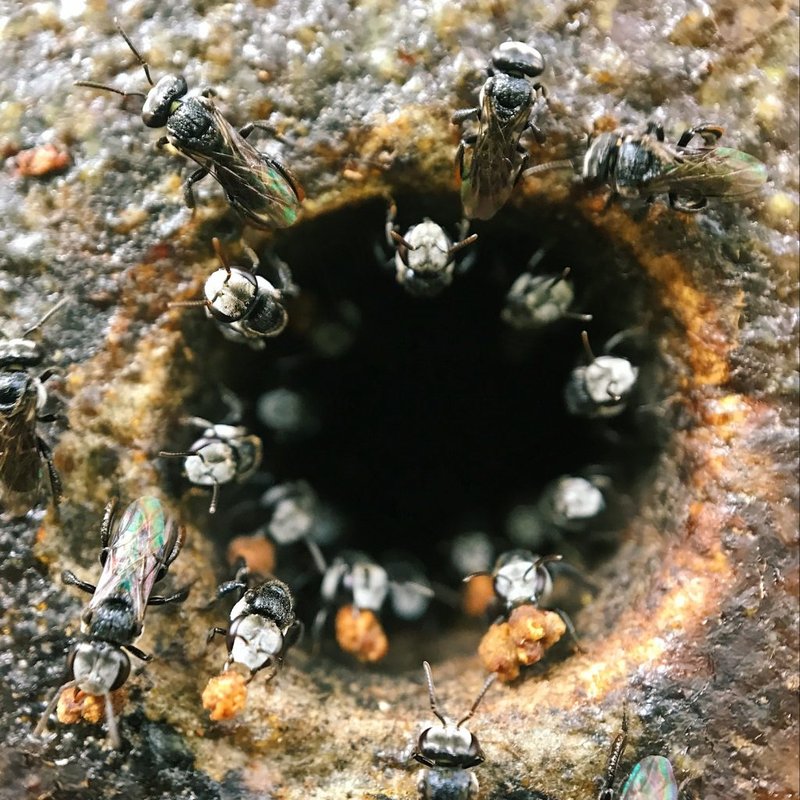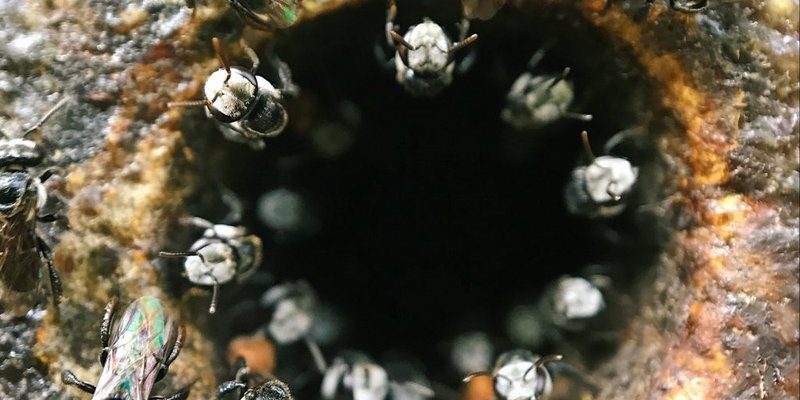
Stingless bees belong to the Meliponini tribe and are found primarily in tropical and subtropical regions. They flourish in places like Central America, South America, Africa, and parts of Asia and Australia. Unlike their honeybee cousins, stingless bees don’t have stingers. Instead, they defend their nests using tactics like biting or releasing a mild acid. So, let’s get to know more about where they live and how they create their nests.
Understanding the Habitat of Stingless Bees
Stingless bees are friendly little pollinators that thrive in diverse habitats. They’re most commonly found in tropical and subtropical areas, where they play an essential role in pollinating plants. You might find them buzzing around lush rainforests, gardens, and even urban parks.
These bees prefer environments that offer a variety of flowering plants, as these provide the nectar and pollen they rely on for food. Natural habitats like forests, savannas, and coastal regions are perfect for them. An interesting fact? They often live in areas with a good amount of humidity. This moisture helps them maintain the right conditions inside their nests.
The soil type also matters. Stingless bees tend to avoid sandy or heavily compacted soils. Instead, they like regions where the soil is rich and filled with organic matter. Here’s the thing: their surroundings not only help them thrive but also support the biodiversity of their ecosystems.
Nesting Sites: Where Do They Make Their Homes?
When it comes to nesting, stingless bees are pretty resourceful. They can set up their homes in a variety of places. While you might think of traditional hives like those of honeybees, stingless bees have a different approach. They often build nests in hollow trees, rock crevices, and even in human-made structures like walls or the roofs of houses.
These nests are usually made from a mix of wax, resin, and pollen. The resin provides durability, keeping the nest intact against the weather elements. You might even find them using soil or plant fibers as building materials. The overall structure resembles a small, intricate honeycomb, which can be quite a sight!
What’s cool about their nesting behavior is that they tend to favor specific locations repeatedly. Once a colony finds a good spot, they often return to it year after year, which helps create a thriving ecosystem. This loyalty to their nesting site makes their habitats even more precious.
The Structure of Stingless Bee Nests
Now, let’s dig deeper into how these nests are actually constructed. Stingless bee nests are composed of several chambers. These chambers serve different purposes, from storing food to housing larvae. The bees create a series of hexagonal and cylindrical tubes that are similar to honeycomb but often smaller and more compact.
Inside the nest, there are special areas called brood chambers where the queen lays her eggs. The worker bees maintain these areas diligently, ensuring that the larvae have the right environment to grow. They provide them with food and keep the chambers clean and safe.
It’s fascinating how these tiny creatures structure their homes. Each chamber serves a specific purpose, and the bees work together as a team. This cooperative behavior is crucial for the survival of their colony. You might say it’s like a tiny community working towards a common goal!
Food Storage and Foraging Behavior
Stingless bees are not just master builders; they’re also skilled foragers. They gather nectar and pollen to feed their colony, and they store food supplies inside their nests for times when resources may be scarce. When they venture out to forage, they visit various flowers, collecting nectar and pollen while helping with pollination in the process.
Interestingly, they have a unique foraging technique called “buzz pollination.” This involves vibrating their bodies to dislodge pollen from certain flowers. Some plants, like tomatoes and blueberries, benefit significantly from this method. By doing so, stingless bees help ensure that plants produce healthy fruits.
Once the bees collect nectar, they convert it into a substance similar to honey. This sweet treat is not just their food; it also serves as an energy source for adults and sustains the larvae. Think about it: it’s like having a pantry stocked with delicious goodies to nourish the entire colony!
Colony Dynamics and Reproduction
In a typical stingless bee colony, you’ll find a queen, workers, and drones. The queen is the heart of the colony, responsible for laying eggs. Worker bees take on various roles, from foraging to caring for the brood. Drones, which are the males, have one main goal: to mate with the queen.
The dynamics within the colony are fascinating. Worker bees communicate through dances and pheromones, sharing vital information about food sources and nest maintenance. Their social structure is quite similar to that of honeybees, but with some differences in behavior and communication.
When it’s time for the queen to mate, she will leave the nest to fulfill her duty. This process is essential for the continuation of the colony, as it ensures genetic diversity. After mating, the queen returns to the nest, laying up to 2,000 eggs daily during peak seasons. Imagine that—talk about busy bees!
The Role of Stingless Bees in the Ecosystem
Stingless bees play an unsung hero role in our ecosystems. As we’ve seen, their foraging habits help pollinate plants, which is crucial for food production—both for us and wildlife. Many fruits, vegetables, and nuts rely on these tiny pollinators to thrive. Without them, biodiversity would suffer, and ecosystems could collapse.
Another interesting point is their relationship with plants. Stingless bees often visit specific flowers, creating mutualistic relationships. In return for nectar, they facilitate the pollen transfer necessary for plant reproduction. It’s a win-win!
By fostering healthy habitats and maintaining biodiversity, stingless bees contribute to the well-being of all living organisms. Sometimes, we overlook the small creatures that have a big impact, but they remind us that every being, no matter how tiny, has its place in the grand scheme of life.
Challenges and Conservation Efforts
Like many pollinators, stingless bees face threats from habitat destruction, climate change, and pesticide use. These challenges can impact their populations and the delicate balance of ecosystems. Deforestation, in particular, poses a significant risk, as it destroys their natural nesting sites and food sources.
Conservation efforts are essential to protect these vital pollinators. Planting native flowers, creating bee-friendly gardens, and minimizing pesticide use can encourage healthy populations. Many organizations are working to increase awareness about the importance of stingless bees and promote their conservation.
Honestly, it starts with us. By appreciating and protecting the habitats of stingless bees, we’re not just helping them; we’re also supporting our ecosystems. So next time you spot one of these buzzing wonders, remember the role they play in nature.
In conclusion, the habitat and nesting behavior of stingless bees are not just fascinating but essential to our environment. These little bees contribute significantly to our food systems and biodiversity. Their unique nesting habits and social structures showcase how interconnected life can be. Let’s celebrate these tiny, stingless pollinators and do our part to protect their homes!

